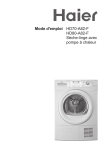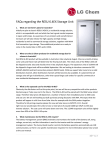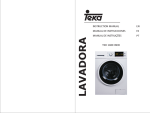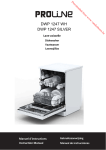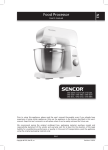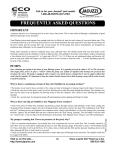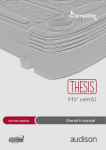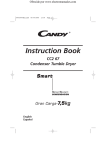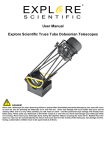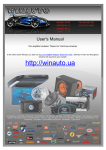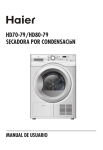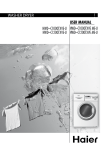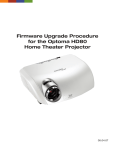Download User Manual HD70-A82 HD80-A82 Heat Pump Dryer
Transcript
User Manual HD70-A82 HD80-A82 Heat Pump Dryer TABLE OF CONTENTS Dear customer ................................................................................................3 Scope of delivery ............................................................................................3 Intended use ...................................................................................................3 Safety instructions .........................................................................................4 Unpacking .......................................................................................................6 Installation ......................................................................................................6 Using the dryer rack ....................................................................................... 7 Front view .......................................................................................................8 Rear view .........................................................................................................9 Control panel ................................................................................................10 Program modes ............................................................................................12 Preparing the dryer ...................................................................................... 13 Preparing the laundry .................................................................................. 13 Loading the dryer .........................................................................................14 Care chart ......................................................................................................14 Load reference ..............................................................................................15 Set program & start ......................................................................................15 End of dry cycle ............................................................................................16 Empty the water tank ................................................................................... 16 ........................................................................................17 ............................................................................ 17 Heat pump technology ................................................................................. 18 Consumption table ....................................................................................... 18 Cleaning & care ............................................................................................19 Error codes ...................................................................................................19 Troubleshooting ...........................................................................................20 Electric circuit diagram ................................................................................ 21 Customer service .........................................................................................22 2 | English DEAR CUSTOMER Instructions showing this icon need special attention for safe handling. Thank you for your purchase of a Haier product. Please read the manual and safety instructions carefully and keep them for future reference and pass them on to any future owner. SCOPE OF DELIVERY 1 2 Please check, if the accessories and literature is in accordance with this list. 1 User manual 2 Rack INTENDED USE This heat pump tumble dryer is designed for household use only. It should be used to dry items which have been washed in a water solution and are marked on the manufacturer's care label as being suitable for tumble drying. It is not intended for commercial or outdoor use. Haier cannot be held liable for damage resulting from incorrect or improper use or operation. This tumble dryer conforms to current safety requirements. English | 3 SAFETY INSTRUCTIONS r The tumble dryer must NOT be used by people with reduced physical, sensory or mental capabilities, or lack of experience or knowledge, if they are supervised when using it or have been shown how to use it in a safe way and understand the hazards involved. Children under 8 years of age must be kept away from the tumble dryer unless they are constantly supervised. r Children 8 years and older may only use, clean or maintain the tumble dryer without supervision if they have been shown how to do so in a safe way and understand the hazards involved. r The tumble dryer is not a toy! To prevent the risk of injury, do not allow children to play with it or near it, or to play with the controls. r Before setting up the tumble dryer, check it for any externally visible damage. r Do not install or use a damaged tumble dryer. r Before connecting the tumble dryer, ensure that the connection data match the mains electricity supply. if in any doubt, consult a qualified electrician. r The electrical safety of this tumble dryer can only be guaranteed when correctly earthed. r Do not connect the tumble dryer to the mains electricity supply by an extension lead. r If the supply cord is damaged, it must be replaced by the manufacturer, its service agent or similarly qualified person. r Faulty components must be replaced by original spare parts. r The tumble dryer must be isolated from the mains supply in the event of a fault and during cleaning and maintenance. r Do not install the tumble dryer in a room where there is a risk of frost occurring. The ambient temperature should be between 5 °C and 35 °C. r Do not install the tumble dryer behind a lockable door, a sliding door or a door with hinges on the opposite side of the tumble dryer door as this limits the full opening of the tumble dryer door. r Always keep the area around the tumble dryer free of dust and lint. Also make sure that the area is dry and well ventilated. r The tumble dryer must not be used in a non-stationary location (e.g. a ship). r Do not make any alterations to the tumble dryer, unless authorised to do so by Haier. r In areas which may be subject to infestation by cockroaches or other vermin, pay particular attention to keeping the tumble dryer and its surroundings in a clean condition at all times. r Do not dry unwashed items in the tumble dryer. r Do not load more than Nominal load. r Items which contain residues of inflammable substances such as cooking oil, acetone, alcohol, benzine, petrol, kerosene, spot removers, turpentine, waxes, wax removers or other chemicals should not be dried in the tumble dryer. r If it is unavoidable to dry items that contain vegetable oil, cooking oil, hair care or cosmetical products, they should be washed using additional detergent and select a high temperature. If in doubt, wash the items several times. 4 | English r Items which contain a large proportion of rubber, foam rubber (latex foam) or rubber like materials such as shower caps, waterproof textiles, rubberised articles and items of clothing and pillows with foam rubber filling should not be dried in the tumble dryer. r Items which have been cleaned using chemicals such as professional drycleaning agents, should not be dried in the tumble dryer. r Do not dry damaged items which contain padding or fillings (e.g. pillows, jackets), as the filling can get out with the risk of igniting in the dryer. r Remove all items such as lighters and matches from pockets. r The end of a dryer cycle runs without heat (cool down cycle) to ensure that the items do not get damaged and are at a handleable temperature. r Warning: Do not switch the tumble dryer off before the drying cycle is finished. Afterwards, the laundry must be hung up or spread out to cool it down. r Fabric softeners and similar products must be used as specified by the manufacturer's packaging. r The dryer must not be used without the lint filters in place or with damaged filters. r The lint filters must be cleaned regularly. r Close the door once the laundry is removed to prevent children, animals and objects getting into the drum. r Do not sit or lean on the door, as this can cause the tumble dryer to tilt. r Condensed water is not drinking water. It can cause health problems in both people and animals. English | 5 UNPACKING Remove all packaging material including the polystyrene base. All packaging material should be recycled. 1 Cut the strips. 2 Lift the cover upwards. 3 Remove the protective parts. 4 Remove the base. 1 2 3 4 1 2 Ensure that any plastic wrappings, bags, etc are kept out of the reach of babies and young children. Danger of suffocation. INSTALLATION WARNING. Following transportation and installation, you MUST leave the dryer to stand for two hours before use. 1 Check the dryer does not rock or wobble.Adjust the four feet to level the dryer before operation. 2 Make sure the socket meets the requirements and connect it to an earthed socket outlet. • Do not install in a room which is susceptible to frost. Water may cause damage once it starts to freeze. • Transport the dryer in a vertical upright position. • There may be residual water in the dryer. This can leak out if the dryer is at an angle. TECHNICAL DATA Power Nominal load (kg) HD70-A82 HD80-A82 Drying programs Max. power (W) Fuse (A) Ambient temperature (°C) Dimensions (H x D x W mm) Net weight (kg) Water protection level 6 | English 220 - 240 V~ / 50 Hz 7 8 12 900 min. 10 5 - 35 845 x 650 x 595 approx. 51,5 IPX4 power consumption in left on mode: 0.05 W power consumption in off mode: 0.05 W For further technical information, please check the type plate on the appliance. Do not dispose of electrical appliances as unsorted municipal waste, use separate collection facilities.Contact your local government for information regarding the collection systems available. If electrical appliances are diaposed of in landfills or dumps, hazardous substances can leak into the groundwater and get into the food chain, damaging your health and well-being. When replacing old appliances with new ones, the retailer is legally obligated to take back your old appliance for diaposals at least free of charge. USING THE DRYER RACK DRYER RACK The dryer rack is designed for use with items which are not recommended for tumble drying such as trainers, sneakers, sweaters or delicate lingerie. TO USE THE DRYER RACK 1. Open the dryer door. 2. Check that the drum is empty. 3. Put the dryer rack into the drum. 4. Make sure the catches are inserted in the hole of the lint filter and locked in the hook of basket. Hook of basket Drum openings Drum Dryer rack Lint filter PLEASE NOTE r Do not use this dryer rack when there are other clothes in the dryer. r During drying, please make sure the items are placed on the rack with r The dryer rack must be used with the “Timer”, “Wool” or “Rack”, “Cool Air” cycle. r Maximum weight of wet items: 1.5kg. English | 7 FRONT VIEW The pictures may differ from the appliance you have purchased due to technical improvements. 1 4 2 3 1 Water tank 2 Tumble dryer door 8 | English 3 Service door 4 Control panel REAR VIEW 5 7 6 8 5 Power supply cord 6 Back plate 7 Drainage outlet 8 Adjustable feet English | 9 CONTROL PANEL 1 2 3 4 5 6 7 Synthetic Start Delay + Timer L Temp. H M - Extra Dry Extra Dry Ready to Store Ready to Iron Ready to Store Ready to Iron Sport Delicate 8 Anti-Crease 9 Rack 10 Cool Air 11 Cotton Power Mix Towel Timer Wool Baby Garment Start/Pause 12 13 14 1 Temp button Set temperature to the desired level. 2 Start Delay button Press button for delayed start (in 1 hour intervals -up to 19 hours). The appliance should be the delayed operation. 3 Filters must be cleaned regularly. See Lint Filter Cleaning or Condenser Filter Cleaning section of the manual. 4 Display The display shows the remaining time, the delay time and other related information. Note: The remaining time is a default value, this time will be re-calculated depending on additional program settings and the moisture content of the laundry. 5 Child-lock indicator To activate the Child-lock function after a cycle has been started, press the Rack & Cool-Air buttons for 3 sec. until the indicator lights up. To deactivate press both button for 3 sec. again. Note: When the cycle ends or the power supply is interrupted the function will be deleted automatically. 10 | English 6 Timer buttons Modify the default time to your needs, using the + and - timer buttons. 7 Empty tank indicator Water tank must be emptied. Important: Empty the water tank after each drying cycle. See Empty the water tank section of the manual. 8 Delicate button Use this function for delicate fabrics. It lowers the temperature and lengthens the drying cycle time to take better care of the laundry. 9 Anti-Crease button Use this function to lengthen the automatic anticrease phase at the end of each program by 60 minutes. Note: The laundry can be removed at any time during the anti-crease phase. 10 Rack button Press the Rack button if the rack should be used in a drying cycle. 11 Cool Air button Use this function for fabrics that can not be dried with one of the heat settings. 12 Start/Pause button Press Start/Pause to Start a drying cycle. Press button again to pause the drying cycle – indicator light is flashing. Press button again to continue. 13 Program knob Select one of the 12 programs using this knob. The indicator of the respective program lights up. See Program Modes section of the manual for further information. 14 Power button Press Power button to switch on/off the tumble dryer. signal You can choose signal as you need. To activate the signal function after the Cool air cycle has been selected, press temp & delicate for 5 sec. until the screen show beep on. To deactivate press both button for 5 sec. again until the screen show beep off. English | 11 SPECIAL SYNTHETICS COTTON / LINEN PROGRAM MODES PROGRAM DRYING DEGREE RECOMMENDED LAUNDRY MAX. LOAD HD80 HD70 Extra Dry Extra dry Heavy cotton, sheets, gowns 8 kg 7 kg Ready to Store *) Ready to wear Cotton, sheets, coats 8 kg 7 kg Ready to Iron Damp Ordinary cotton 8 kg 7 kg Extra Dry Extra dry Heavy synthetic 4 kg 4 kg Ready to Store Ready to wear Ordinary synthetic 4 kg 4 kg Ready to Iron Ready to wear Ordinary synthetic 4 kg 4 kg Sport Ready to wear Sportswear 4 kg 4 kg Towel Ready to wear Towels 8 kg 7 kg Wool **) Fluff but not dry Woollen clothing 1 kg 1 kg Baby Garment Ready to wear Baby clothing 4 kg 4 kg Timer Ready to wear Heavy fabrics, need further drying 8 kg 7 kg Mix Ready to wear Heavy fabrics, need further drying 4 kg 4 kg *) EN 61121 test program setting. **) Special program for careful treating of woollen fabrics with warm air, after they have been worn or stored for long periods. Wool fibres stand up and the wool becomes soft and cosy. 12 | English PREPARING THE DRYER 1 Connect the tumble dryer to a power socket. 2 Make sure the water tank is empty and properly installed. 3 Make sure that the lint filter is clean and properly installed. 4 Make sure that the condenser filter is clean and properly installed. PREPARING THE LAUNDRY 1 2 3 4 1 2 1 Sort clothes according to fabric (cotton, synthetics, wool etc.). Only laundry that has been spun. 2 Empty pockets of all sharp or flammable objects such as keys, lighters and matches. Remove harder decorative objects such as brooches. Follow the instructions on the laundry label and dry only machine-dryable garments. Do not dry silk, down or other delicate fabrics to avoid damage to the laundry. – Close zippers and hooks, make sure the buttons are sewn on tightly and place small items such as socks, bras etc. in a wash bag. – Unfold large pieces of fabric such as bed sheets, table cloth etc. English | 13 LOADING THE DRYER 1 2 1 Place the laundry evenly in the drum making sure not to overload the dryer. 2 Switch on the tumble dryer by pressing the Power button. Fabric softeners or similar products manufacturer’s instructions. CARE CHART Resistant material Bleachable in cold water Do not dry clean Delicate fabric Do not bleach Dry flat Washable at 95 °C Iron at 200 °C Hang to dry Washable at 60 °C Iron at 150 °C Dry on clothes hanger Washable at 40 °C Iron at 100 °C Tumble dry (normal heat) Washable at 30 °C Do not iron Tumble dry (reduced heat) Hand wash Dry cleaning (any solvent) Do not tumble dry Dry clean only Dry cleaning (pericloride) Wool seal Dry cleaning (aviation fuel) 14 | English LOAD REFERENCE Bed sheet (single) Cotton Approx. 800 g Blended fabric clothes / Approx. 800 g Jackets Cotton Approx. 800 g Jeans / Approx. 800 g Overalls Cotton Approx. 950 g Pyjamas / Approx. 200 g Shirts / Approx. 300 g Socks Blended fabrics Approx. T-Shirts Cotton Approx. 300 g Underwear Blended fabrics Approx. SET PROGRAM & START 1 50 g 70 g 2 1 Turn the program knob to select the desired program. It can be modified by use of the Timer and Temperature buttons. 2 Set functions such as Delay, Delicate, Anti-Crease. Afterwards press the Start/Pause button to start the dry cycle. ENVIRONMENTAL TIPS – Spin the laundry as dry as possible before putting it into the tumble dryer. – Avoid overloading the tumble dryer. – Shake the laundry loose before putting it into the tumble dryer. – Choose a proper drying program. Make sure the laundry is not dried longer than needed. – Make sure to use the tumble dryer with cleaned filters. English | 15 END OF DRY CYCLE 1 2 3 4 The tumble dryer stops operation automatically when a dry cycle is complete. The display shows END. Open the tumble dryer door and remove the laundry. If the laundry is not removed the anti-crease program starts automatically. 1 Switch off the tumble dryer by pressing the Power button. 2 Unplug the tumble dryer from the power socket. 3 Empty the water tank after each dry cycle. 4 Clean the lint filter after each dry cycle. 5 Clean the condenser filter approx. every 20 dry cycles. EMPTY THE WATER TANK 5 1 During operation, steam condenses to water which is collected in the water tank. Empty the water tank after each drying cycle. 1 Pull out the water tank from its housing. 2 Empty the water tank. 3 Reinstall the water tank to the tumble dryer. Note: Do not use the water for any kind of drinking or food processing. 16 | English 3 2 LINT FILTER CLEANING 1 2 3 4 1 2 3 4 5 6 cycle. 1 Re move the lint filter from the drum. 2 Open up the lint filter. 3 Clean the lint filter form any lint residuals. 4 Reinstall the cleaned lint filter in the tumble dryer. can be cleaned under running water. Let it dry thoroughly before use. CONDENSER FILTER CLEANING !! " every 20 dry cycles. 1 Open the Service door. 2 Open the four levers of the condenser filter. 3 Pull out the condenser filter from its housing. 4 Remove the rear filter screen. 5 Clean the condenser filter form any residuals. 6 Reinstall the rear filter to the condenser filter. To reinstall the condenser filter, follow the above steps 3 to 1 in reverse order. dirty, it can be cleaned under running water. Let it dry thoroughly before use. English | 17 HEAT PUMP TECHNOLOGY The condensation dryer with heat exchanger is outstanding in terms of These are guide values determined under standard conditions. The values may differ from those given, depending on overvoltage and undervoltage, the type of fabric, composition of the laundry to be dried, the residual moisture in the fabric and the size of the load. CONSUMPTION TABLE Program Spin Speed in rpm Energy (Residual Moisture) Consumption COTTON / LINEN HD80 8kg HD70 7kg DRYING TIME HD80 HD70 7kg 8kg Extra Dry 1000 (approx. 60 %) 2.08 kwh 1.84kwh 2:50 h 2:28 h Ready to Store 1000 (approx. 60 %) 1.95 kwh 1.73kwh 2:40 h 2:20 h Ready to Iron 1000 (approx. 60 %) 0.90 kwh 0.8kwh 1:06 h 18 | English 1:15 h CLEANING & CARE TUMBLE DRYER Wipe the outside of the tumble dryer and the control panel with a damp cloth. Do not use any organic solvent or corrosive agent to avoid damage to the device. DRUM After some operation time, fabric care agents or calcium contained in the water some detergent to remove it. Do not use any organic solvent or corrosive agent to avoid damage to the device. EVAPORATOR a vacuum cleaner. Make sure not to damage the evaporator while cleaning it. ERROR CODES CODE CAUSE SOLUTION F2 Drain pump error. Contact the customer service. F31, F32, F33 The condenser thermal sensor is open-circuited or short-circuited. Contact the customer service. F4 Temperature of the laundry in the drum does not change. Contact the customer service. E6 The filters is clogged. Clean both filters. E7 Under voltage or over voltage fault. Check the voltage of power suply. Or contact the customer service. E8 Over load warning. Reduce the load,Repower the dryer. Or contact the customer service. Lo Temperature is too low. Use the dryer when air temperature is higher than 2 ℃. English | 19 TROUBLESHOOTING Before contacting the customer service, please check the following circumstances: PROBLEM CAUSES SOLUTION Tumble dryer – Poor connection to the fails to operate. power supply. – Power failure. – No drying program is set. – Device has not been switched on. – The water tank is full. – The door is not closed properly. ▪ Tumble dryer – The laundry has reached fails to operate the condition defined by and the display the program. shows END. – There is no laundry in the drum. ▪ Check if the program setting is appropriate. ▪ Check if there is laundry in the drum. Drying time is too long and the results are not satisfactory. – The program setting is not correct. – The filter is clogged. – The evaporator is blocked. – The tumble dryer is overloaded. – The laundry is too wet. ▪ Make sure the program is set correctly. Clean the filter screen. Clean the evaporator. Reduce the amount of laundry. – The vent duct is blocked. ▪ ▪ ▪ ▪ ▪ ▪ ▪ ▪ ▪ ▪ Check connection to the power supply. Check the power supply. Set a drying program. Switch the device on. Empty the water tank. Close the door properly. Spin the laundry properly before drying. Check the vent duct and unblock it. The automatic adjustment is a Remaining time The remaining time will be on the display adjusted continuously based normal operation. stops or skips. upon the following factors: – Type of laundy. – Loaded amount. – Moisture degree of the laundry. – Ambient temperature. 20 | English ELECTRIC CIRCUIT DIAGRAM K1 H K2 NTC1 NTC2 NTC3 L G N PCB HP K1 K2 H NTC1 NTC2 NTC3 DP Door switch Water level switch Humidity sensor Temperature sensor Temperature sensor Temperature sensor L F M HP DP L F M Heat pump Drainage pump Lamp Fan motor Motor English | 21 CUSTOMER SERVICE If you have a problem with your appliance, first see the Troubleshooting section of the manual. If you cannot find a solution there, please contact your local dealer or try one of the following numbers. Before contacting the customer service, ensure that you have the following data available. The data can be found on the rating plate: MODEL SERIAL NUMBER Also check the Warranty Card supplied with the product in case of warranty. COUNTRY PHONE NUMBER COSTS Haier Italy (IT) 199-100 912 Haier Spain (ES & PT) 902 509 123 Haier Germany (DE) 0180 5 39 39 99* * 14 Ct/Min Landline / max. 42 Ct/Min Mobile Haier Austria (AT) 0820 001 205* * 14,53 Ct/Min Landline / max. 20 Ct/Min all others Haier United Kingdom (UK) 0845 025 30 25 Haier France (FR) 0980 406 409 For other countries please refer to the service and support area of: www.haier.com. 22 | English Mode d'emploi HD70-A82-F HD80-A82-F Sèche-linge avec pompe à chaleur Manual del usuario HD70-A82 HD80-A82 Secadora con bomba de calor ÍNDICE DE CONTENIDO Estimado cliente .............................................................................................3 elementos de suministro ............................................................................... 3 Uso previsto ....................................................................................................3 Instrucciones de seguridad ........................................................................... 4 Desembalaje ...................................................................................................6 Instalación .......................................................................................................6 Utilización del cesto ....................................................................................... 7 Vista frontal .....................................................................................................8 Vista posterior ................................................................................................9 Panel de control ...........................................................................................10 Programas .....................................................................................................12 Preparación de la secadora ......................................................................... 13 Preparación de la ropa ................................................................................. 13 Carga de la secadora ................................................................................... 14 Símbolos de lavado ...................................................................................... 14 Referencias de carga ................................................................................... 15 Selección del programa y puesta en marcha ............................................ 15 Finalización del ciclo de secado ................................................................. 16 Vaciado del depósito de agua ..................................................................... 16 ..................................................................... 17 ................................................................. 17 Tecnología de bomba de calor .................................................................... 18 Tabla de consumos ......................................................................................18 Limpieza y cuidado ...................................................................................... 19 Códigos de error ..........................................................................................19 Solución de problemas ................................................................................ 20 Esquema eléctrico ........................................................................................21 Servicio de atención al cliente .................................................................... 22 2 | Español ESTIMADO CLIENTE Las instrucciones con este símbolo requieren que preste especial atención para garantizar la seguridad. Gracias por haber adquirido un producto Haier. Lea detenidamente el manual y las instrucciones de seguridad, guárdelos como referencia para el futuro y entréguelos al nuevo propietario en caso de traspasar aparato. ELEMENTOS DE SUMINISTRO 1 2 Compruebe que tenga los accesorios y documentos indicados a continuación. 1 Manual del usuario 2 Cesto USO PREVISTO Esta secadora con bomba de calor está diseñada exclusivamente para uso doméstico. Únicamente debe utilizarse para secar prendas lavadas previamente en una solución acuosa que sean aptas para secadora de acuerdo con la etiqueta del fabricante. No está prevista para uso comercial ni en exteriores. Haier no se hará responsable de los daños derivados del uso u operación incorrectos o inadecuados. Esta secadora cumple las normas de seguridad en vigor. Español | 3 INSTRUCCIONES DE SEGURIDAD t Solo se permite el uso de la secadora por parte de personas con limitaciones físicas, psíquicas o sensoriales, o que no tengan la experiencia o los conocimientos necesarios, bajo la supervisión de otra persona o si se les ha enseñado cómo utilizarla con seguridad y conocen los peligros potenciales. t Los menores de 8 años deben mantenerse alejados de la secadora siempre que no estén bajo la supervisión directa de un adulto. t Los niños mayores de 8 años solo deben utilizar, limpiar o mantener la secadora sin vigilancia si se les ha enseñado cómo hacerlo con seguridad y conocen los peligros potenciales. t ¡La secadora no es un juguete! Para evitar posibles daños personales, no permita que los niños jueguen con ella o cerca de ella, ni que toquen los mandos. t Antes de instalar la secadora, compruebe que no presente daños visibles. t No intente instalar ni utilizar una secadora deteriorada. t Antes de conectar la secadora, asegúrese de que los datos de conexión coincidan con los del suministro eléctrico. En caso de duda, consulte a un electricista cualificado. t La única manera de garantizar la seguridad eléctrica de la secadora es por medio de una toma a tierra correcta. t No utilice cables alargadores para conectar la secadora al suministro eléctrico. t Si el cable de alimentación está deteriorado, su sustitución deberá encargarse al fabricante, a un agente de servicio oficial o a otro técnico debidamente cualificado. t Los componentes averiados deben sustituirse por repuestos originales. t En caso de producirse un fallo y durante los trabajos de mantenimiento y limpieza, la secadora deberá aislarse del suministro eléctrico. t No instale la secadora en lugares con riesgo de escarcha. La temperatura ambiente debe permanecer entre 5 °C y 35 °C. t No instale la secadora detrás de una puerta con cerradura, corrediza o con bisagras en dirección opuesta a la secadora, puesto que la puerta de la secadora no podría abrirse completamente. t Mantenga siempre la zona alrededor de la secadora limpia de polvo y pelusas. Asegúrese también de que el lugar esté seco y bien ventilado. t No está permitido utilizar la secadora en lugares que puedan moverse (p. ej. en un barco). t No realice modificaciones no autorizadas por Haier en la secadora. t En los lugares con riesgo de infestación de cucarachas y otros insectos, preste especial atención a que la secadora y sus alrededores estén siempre limpios. t No utilice la secadora para secar ropa que no se haya lavado previamente. t No supere la carga nominal. t No intente secar prendas con restos de sustancias inflamables como aceite de cocina, acetona, alcohol, bencina, gasolina, queroseno, quitamanchas, aguarrás, ceras, quitaceras y otros productos químicos. t Si fuera inevitable tener que secar prendas con restos de aceite vegetal, aceite de cocina o productos cosméticos o capilares, lávelos previamente con una cantidad adicional de detergente y a alta temperatura. En caso de duda, realice varios lavados. 4 | Español t No intente secar prendas con grandes cantidades de goma, gomaespuma (látex) o materiales similares, como gorros de ducha, prendas impermeables, artículos recubiertos de caucho o ropa y almohadas con relleno de gomaespuma. t No intente secar prendas que se hayan limpiado previamente con productos químicos, como, por ejemplo, productos profesionales de lavado en seco. t No intente secar artículos deteriorados que contengan acolchados o rellenos (como almohadas o chaquetas), ya que el relleno podría salirse e inflamarse dentro de la secadora. t Extraiga todos los objetos de los bolsillos, como por ejemplo mecheros y cerillas. t El final del ciclo de secado se desarrolla sin calor (enfriamiento) para asegurarse de que las prendas no resulten dañadas y estén a una temperatura moderada. t Advertencia: no apague la secadora antes de que termine el ciclo de secado. Acto seguido, cuelgue o extienda la ropa para que se enfríe. t Los suavizantes y productos similares deben utilizarse de acuerdo con las indicaciones del envase del fabricante. t No utilice la secadora sin los filtros de pelusas o si estos están deteriorados. t Los filtros de pelusas deben limpiarse con regularidad. t Cuando haya retirado la ropa de la secadora, cierre la puerta para evitar que puedan entrar niños, animales u objetos a su interior. t No se siente ni apoye en la puerta, ya que podría hacer volcar la secadora. t El agua condensada no se puede beber, ya que puede provocar problemas de salud tanto en personas como en animales. Español | 5 DESEMBALAJE 1 2 3 4 1 2 Retire todo el material de embalaje, incluida la base de poliestireno. Todo el material de embalaje debe reciclarse. 1 2 3 4 Corte las cintas. Levante la cubierta. Retire los protectores. Retire la base. Asegúrese de que los plásticos, bolsas, etc. permanezcan en todo momento fuera del alcance de los bebés y los niños pequeños. Peligro de asfixia. INSTALACIÓN 1 Antes de utilizar el aparato, nivele las cuatro patas. 2 Compruebe que la toma de corriente cumpla con los requisitos especificados y que esté conectada a tierra. • No instale la secadora en un lugar donde pudiera formarse escarcha, puesto que el agua congelada podría dañarla. • Transporte la secadora de pie y en posición vertical. Después de transportar la secadora, déjela reposar durante dos horas. • Podría haber restos de agua en el interior de la secadora. Si la secadora está inclinada, podría producirse una fuga de agua. DATOS TÉCNICOS Alimentación 220 - 240 V~ / 50 Hz Carga nominal (kg) HD70-A82 7 HD80-A82 8 Programas de secado 12 Máx. potencia (W) 900 Fusible (A) Mín. 10 Temperatura ambiente (°C) 5 - 35 Dimensiones en mm (Al x Pr x An) 845 x 650 x 595 Peso neto (kg) Aprox. 51,5 Nivel de protección contra el agua IPX4 6 | Español Consumo de potencia en modo encendido: 0.05 W Consumo de potencia en modo apagado: 0.05 W Para conocer el resto de información técnica, consulte la placa de características del aparato. No deseche los aparatos eléctricos como residuos urbanos sin clasificar, utilice las instalaciones de recogida selectiva. Póngase en contacto con los representantes gubernamentales de su municipio para obtener información en relación con los sistemas de recogida disponibles. Si los aparatos eléctricos se desechan en vertederos o basureros, las sustancias peligrosas se podrían filtrar en las aguas subterráneas y llegar hasta la cadena alimenticia, lo que supondría un daño para su salud y bienestar.Para la sustitución de aparatos antiguos por nuevos, el vendedor está legalmente obligado a aceptar los aparatos viejos para encargarse de su eliminación al menos y de forma gratuita. UTILIZACIÓN DEL CESTO CESTO El cesto está diseñado para colocar prendas que no se pueden hacer girar durante el secado, como zapatillas deportivas, jerséis o lencería. CÓMO UTILIZAR EL CESTO 1. Abra la puerta de la secadora. 2. Compruebe que el tambor esté vacío. 3. Coloque el cesto en el tambor. 4. Asegúrese de que los enganches estén introducidos en el orificio del filtro de pelusas y fijados en el gancho. Gancho del cesto Aberturas del tambor Tambor Cesto Filtro de pelusas ATENCIÓN • No utilice el cesto cuando haya otras prendas de ropa en el interior de la secadora. • Cuando coloque prendas en el cesto, asegúrese de que no exista rotación del tambor. • La secadora debe utilizarse con los programas “Temporizador”, “Lana”, “Cesto” o “Aire fresco”. • Peso máximo de las prendas mojadas: 1,5 kg. Español | 7 VISTA FRONTAL Las ilustraciones podrían diferir del aparato real debido a las mejoras tecnológicas. 1 4 2 3 1 Depósito de agua 2 Puerta de la secadora 8 | Español 3 Puerta de mantenimiento 4 Panel de control VISTA POSTERIOR 5 7 6 8 5 Cable de alimentación 6 Placa trasera 7 Salida de drenaje 8 Patas ajustables Español | 9 PANEL DE CONTROL 1 2 3 4 5 6 7 Sintéticos Extra Seco Inicio diferido M L Temp. Para plancha Temporizador - H Extra Seco Algodón Para guardar Para Encendido plancha Para guardar + Sport Mixtos Temporizador Toallas Ropa de Bebé Lana Delicados 8 Antiarrugas 9 Cesto 10 Aire frío 11 1 Botón de temp Inicio/Pausa 12 13 14 Permite ajustar la temp al nivel deseado. 2 Botón de inicio diferido horas, en intervalos de 1 hora). El aparato debe estar preparado. A continuación, pulse el botón Inicio/Pausa para activar el inicio diferido. 3 Indicadores de limpieza Consulte el apartado pelusas o manual. 4 Pantalla del En la pantalla se muestra el tiempo restante, el tiempo de inicio diferido y otra información relacionada. Nota: el tiempo restante es un valor selección de programas adicionales y de la humedad de la ropa. 5 Indicador del bloqueo infantil Para activar la función de bloqueo infantil una vez que haya comenzado un ciclo, pulse los botones Cesto y Aire fresco durante 3 seg. hasta que el indicador se ilumine. Para desactivarla, mantenga pulsados de nuevo ambos botones durante 3 segundos nuevamente. Nota: esta función se desactiva produce un corte en la alimentación eléctrica. 10 | Español 6 Botones del temporizador Los botones + y - del temporizador permiten 7 Indicador de vaciado del depósito Es necesario vaciar el depósito de agua. Importante: vacíe el depósito de agua después de cada ciclo de secado. Consulte el apartado Vaciado del depósito de agua del manual. 8 Botón de Delicados delicadas Utilice esta función para los tejidos delicados. Reduce la temperatura y alarga la duración del ciclo de secado para mejorar el cuidado de la ropa. 9 Botón antiarrugas Utilice esta función para alargar 60 minutos la fase antiarrugas automática que se lleva a cabo Nota: durante la fase antiarrugas, la ropa puede quitarse en cualquier momento. 10 Botón del cesto Presione el botón Cesto para utilizar el cesto en un ciclo de secado. 11 Botón de aire frio Utilice esta función con los tejidos que no puedan secarse utilizando calor. 12 Botón Inicio/Pausa Presione el botón Inicio/Pausa para activar un ciclo de secado. Presiónelo de nuevo para pausar el ciclo (el indicador parpadeará). Presiónelo otra vez para reanudar el ciclo. 13 Rueda de programas Utilice esta rueda para seleccionar uno de los 12 programas disponibles. Se iluminará el indicador del programa seleccionado. Para obtener más información, consulte el apartado Programas del manual. 14 Botón de encendido Presione el botón de encendido para encender/ apagar la secadora. avisos sonoros Puede usted escoger los avisos según sus necesidades. Para activar la función de aviso cuando haya seleccionado el ciclo de Aire frío, pulse “Temp.” Y “Delicados” durante 5 segundos hasta que la pantalla muestre “beep on”. Para desactivarlo pulse ambos botones simultáneamente durante 5 segundos hasta que la pantalla muestre “beep off”. Español | 11 ESPECIAL SINTÉTICOS ALGODÓN / HILO PROGRAMAS PROGRAMA NIVEL DE SECADO RECOMENDADO PARA Extra seco Extraseco Algodón resistente, sábanas, batas 8 kg 7 kg Para guardar *) Listo para usar Algodón, sábanas, abrigos 8 kg 7 kg Listo para planchar Húmedo Algodón normal 8 kg 7 kg Extraseco Extraseco Sintéticos resistentes 4 kg 4 kg Listo para guardar Listo para usar Sintéticos normales 4 kg 4 kg Listo para planchar Listo para usar Sintéticos normales 4 kg 4 kg Sport Listo para usar Ropa deportiva 4 kg 4 kg Toalla Listo para usar Toallas 8 kg 7 kg Lana **) Suave, pero no seco Ropa de lana 1 kg 1 kg Ropa de baby Listo para usar Ropa de bebés 4 kg 4 kg Temporizador Listo para usar Tejidos resistentes, requiere secado adicional 8 kg 7 kg Mixtos Tejidos resistentes, requiere secado adicional 4 kg 4 kg Listo para usar MÁX. CARGA HD80 HD70 *) Programa de la prueba de EN 61121. **) Programa especial para el tratamiento delicado de tejidos de lana con aire caliente, después de haberse utilizado o de haber permanecido guardados suave y agradable. 12 | Español PREPARACIÓN DE LA SECADORA 1 Enchufe la secadora a una toma de corriente. 2 Compruebe que el depósito de agua esté vacío y montado correctamente. 3 Compruebe que el filtro de pelusas esté limpio y montado correctamente. 4 Compruebe que el filtro condensador esté limpio y montado correctamente. PREPARACIÓN DE LA ROPA 1 2 3 4 1 2 1 Ordene las prendas según el tejido (algodón, sintético, lana, etc.). Seque únicamente ropa centrifugada. 2 Extraiga de los bolsillos todos los objetos afilados e inflamables, como llaves, encendedores o cerillas. Retire los objetos decorativos duros, como broches. Siga las instrucciones de las etiquetas de la ropa y seque únicamente ! evitar que la ropa resulte dañada, no seque tejidos de seda, plumón u otros materiales delicados. – Cierre las cremalleras y enganches, compruebe que los botones estén bien hilados y coloque los objetos pequeños, como calcetines, sujetadores, etc. en una bolsa de lavado. – Despliegue las prendas grandes, como sábanas, manteles, etc. Español | 13 CARGA DE LA SECADORA 1 1 Distribuya la ropa uniformemente en el tambor teniendo mucho cuidado de no sobrepasar la capacidad de carga permitida. 2 Encienda la secadora con el botón de Encendido. 2 Encendido Los suavizantes y productos similares deben utilizarse tal como se explica en las indicaciones de empleo del fabricante. SÍMBOLOS DE LAVADO Material resistente Se puede usar lejía en agua fría No lavar en seco Tejido delicado No usar lejía Secar extendido Lavable a 95 °C Planchar a 200 °C Secar extendido en posición vertical Lavable a 60 °C Planchar a 150 °C Secar colgado Lavable a 40 °C Planchar a 100 °C secado a temperatura normal Lavable a 30 °C No planchar secado a temperatura reducida Lavar a mano Lavado en seco (cualquier disolvente) No usar secadora Sólo lavado en seco Lavado en seco (percloruro) Pura lana virgen Lavado en seco (combustible de aviación) 14 | Español REFERENCIAS DE CARGA Sábana (una) Algodón Aprox. 800 g Mezcla de prendas textiles / Aprox. 800 g Chaquetas Algodón Aprox. 800 g Vaqueros / Aprox. 800 g Monos Algodón Aprox. 950 g Pijamas / Aprox. 200 g Camisas / Aprox. 300 g Calcetines Tejidos mixtos Aprox. Camisetas Algodón Aprox. 300 g Ropa interior Tejidos mixtos Aprox. SELECCIÓN DEL PROGRAMA Y PUESTA EN MARCHA 1 Gire la rueda hasta la posición correspondiente al programa que quiera utilizar. Los botones Temporizador y Tepm permiten modificar los parámetros del programa seleccionado. 2 Seleccione las funciones adicionales que necesite (Inicio diferido, Delicados, Antiarrugas). A continuación, presione el botón Inicio/ Pausa para iniciar el ciclo de secado. 1 50 g 70 g 2 Inicio/Pausa CONSEJOS MEDIOAMBIENTALES – Centrifugue la ropa tanto como pueda antes de ponerla en la secadora. – No sobrecargue la secadora. – Sacuda la ropa para soltarla antes de ponerla en la secadora. – Seleccione un programa de secado adecuado. Tenga cuidado de que la ropa no se seque durante más tiempo del necesario. Español | 15 FINALIZACIÓN DEL CICLO DE SECADO 1 Encendido La secadora se detiene automáticamente En la pantalla se muestra FIN. Abra la puerta de la secadora y extraiga la ropa. Si no quita la ropa, se activará automáticamente el programa antiarrugas. 3 1 Apague la secadora con el botón de Encendido. 2 Desenchufe la secadora de la toma de corriente. 3 Vacíe el depósito de agua después de cada ciclo de secado. 4 cada ciclo de secado. 5 aproximadamente cada 20 ciclos de secado. 5 VACIADO DEL DEPÓSITO DE AGUA 1 Durante el funcionamiento, el vapor se condensa en agua, que se recoge en un depósito. Vacíe el depósito de agua después de cada ciclo de secado. 1 Extraiga el depósito de agua de su alojamiento. 2 Vacíe el depósito de agua. 3 Vuelva a montar el depósito de agua en la secadora. Nota: no beba ni permita que el agua entre en contacto con alimentos. 16 | Español 2 3 4 2 LIMPIEZA DEL FILTRO DE PELUSAS 1 2 3 4 1 2 3 4 5 6 " cada ciclo de secado. 1 2 3 4 Extraiga el filtro de pelusas del tambor. Abra el filtro de pelusas hacia arriba. Retire las pelusas del filtro. Una vez limpio, vuelva a montar el filtro de pelusas en la secadora. # limpiarlo con agua corriente. Deje que se seque completamente antes de volver a utilizarlo. LIMPIEZA DEL FILTRO CONDENSADOR aproximadamente cada 20 ciclos de secado. 1 Abra la puerta de mantenimiento. 2 Abra las cuatro palancas del filtro condensador. 3 Extraiga el filtro de su alojamiento. 4 Desmonte la pantalla trasera del filtro. 5 Limpie la suciedad del filtro condensador. 6 Vuelva a montar el filtro trasero en el filtro condensador. Para volver a montar el filtro condensador, lleve a cabo los pasos 3 a 1 anteriores en orden inverso. # limpiarlo con agua corriente. Deje que se seque completamente antes de volver a utilizarlo. Español | 17 TECNOLOGÍA DE BOMBA DE CALOR La secadora con intercambiador de calor tiene un consumo energético excepcional. Los valores indicados son de referencia y bajo condiciones normales. Los sobrevoltajes y subvoltajes, el tipo de tejido, la composición de la ropa que se quiere secar, el nivel de humedad residual en el tejido y el volumen de la TABLA DE CONSUMOS ALGODÓN / HILO Programa Vel. centrif. en r.p.m. (humedad residual) Consumo de energía HD80 HD70 7kg 8kg TIEMPO DE SECADO HD80 HD70 8 kg 7 kg Extra seco 1000 (aprox. 60 %) 2.08 kwh 1.84kwh 2:50 h 2:28 h Para guardar 1000 (aprox. 60 %) 1.95 kwh 1.73kwh 2:40 h 2:20 h Para planchar 1000 (aprox. 60 %) 0.90 kwh 0.8kwh 1:15 h 1:06 h 18 | Español LIMPIEZA Y CUIDADO SECADORA Limpie el exterior de la secadora y el panel de control con un paño húmedo. A corrosivos. TAMBOR Con el tiempo, los productos de cuidado de los tejidos y la cal que contiene el agua pueden formar una película casi invisible en el interior del tambor. Límpiela Español | 19 SOLUCIÓN DE PROBLEMAS Antes de llamar al servicio de atención al cliente, compruebe lo siguiente: PROBLEMA CAUSAS La secadora no – Está mal conectada a la funciona. fuente de alimentación. – Fallo en la alimentación eléctrica. – No se ha seleccionado ningún programa de secado. – El dispositivo no está encendido. – El depósito de agua está lleno. – La puerta está mal cerrada. SOLUCIÓN ▪ ▪ Revise la conexión a la fuente de alimentación. Revise la fuente de alimentación. ▪ Seleccione un programa de secado. ▪ Encienda el equipo. ▪ Vacíe el depósito de agua. ▪ Cierre la puerta correctamente. La secadora no – La ropa ha alcanzado el funciona y en objetivo definido por el la pantalla se programa. visualiza FIN. – El tambor está vacío. ▪ Compruebe que esté seleccionado el programa correcto. Compruebe si hay ropa en el tambor. El tiempo de secado es excesivo y los resultados no son satisfactorios. – No se ha seleccionado el programa correcto. ▪ – El filtro está obstruido. – El evaporador está bloqueado. – La secadora contiene una carga excesiva. – La ropa está demasiado mojada. – El conducto de ventilación está obstruido. ▪ El tiempo restante de la pantalla se detiene o se omite. 20 | Español El tiempo restante se ajusta de manera continua en función de los factores siguientes: – Tipo de ropa. – Volumen de carga. – Nivel de humedad de la ropa. – Temperatura ambiente. ▪ ▪ Compruebe que esté seleccionado el programa correcto. Limpie la pantalla del filtro. Limpie el evaporador. ▪ Reduzca la cantidad de ropa. ▪ Centrifugue bien la ropa antes de secarla. Revise el conducto de ventilación y elimine la obstrucción. ▪ Este tipo de ajuste automático es normal. ESQUEMA ELÉCTRICO K1 H K2 NTC1 NTC2 NTC3 L G N PCB HP K1 K2 H NTC1 NTC2 NTC3 DP L Interruptor de la puerta Interruptor del nivel de agua Sensor de humedad Sensor de temperatura Sensor de temperatura Sensor de temperatura F M HP DP L F M Bomba de calor Bomba de drenaje Indicador Motor del ventilador Motor Español | 21 SERVICIO DE ATENCIÓN AL CLIENTE Si tiene algún problema con el aparato, primero consulte el apartado Solución de problemas del manual. Si no encuentra ahí la solución, póngase en contacto con su distribuidor local o llame a uno de los números que se proporcionan a continuación. Antes de llamar al servicio de atención al cliente, asegúrese de que dispone de la siguiente información. Estos datos se pueden consultar en la placa de categoría: MODELO NÚMERO DE SERIE Compruebe además la tarjeta de garantía que se suministra con el producto en caso de que la necesite. PAÍS NÚMERO DE TELÉFONO Haier Italia (IT) 199-100 912 COSTES Haier España (ES y PT) 902 509 123 Haier Alemania (DE) 0180 5 39 39 99* * 14 cénts./min. (teléfono fijo) / máx. de 42 cénts./min (móvil) Haier Austria (AT) 0820 001 205* * 14,53 cénts./min. (teléfono fijo) / máx. de 20 cénts/min. (todos los demás) Haier Reino Unido (UK) 0845 025 30 25 Haier Francia (FR) 0980 406 409 Para los demás países, consulte el área de servicios y asistencia técnica de: www.haier.com. 22 | Español













































